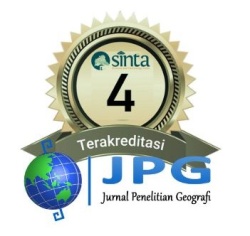Management Evaluation of the Parangtritis Sand Dunes Tourist Attraction Using the DPSIR Approach
Abstract
The Parangtritis Sand Dunes, an important geoheritage area, serves as a natural shield against tsunamis, a rainwater catchment area, and a unique habitat for biodiversity. However, uncontrolled land use change threatens its sustainability. This study uses the DPSIR framework to analyze land use dynamics and propose sustainable management strategies. The results show that inappropriate afforestation policies, infrastructure development, and tourism activities disrupt the aeolin process, thereby reducing the area of sand dunes in the core zone. Some of these things degrade the function of the sand dune ecosystem. Recommendations include enforcing zoning regulations, rerouting tourism jeeps, and educating the community.
Keywords: DPSIR analysis; land cover; land use; sand dunes; sutainability
Full Text:
PDFReferences
Aina, Q., Fauzi, F., & Novialdi, R. (2024). The Role of Islamic Non-Governmental Organizations in Environmental Conservation: A Case Study of the Global Muslim Climate Network (GMCN). Jurnal Penelitian Geografi, 12(2), 223–232. https://doi.org/10.23960%2Fjpg.v12i2.30692
BPS Kabupaten Bantul. (2023). Kecamatan Kretek dalam Angka 2022. BPS Kabupaten Bantul.
Buana, Y., Sugiyanta, I. G., & Zulkarnain, Z. (2015). Perubahan Luas Mangrove Tahun 1994-2014 Melalui Citra Landsat di Kecamatan Padang Cermin. Jurnal Penelitian Geografi, 3(1). https://doi.org/10.23960%2Fjpg.v3i1.8202
Dahm, J. (2005). Coastal hazards and climate change: A guidance manual for local government in New Zealand. New Zealand Ministry for the Environment.
Martinez, M. L., Psuty, N. P., & Lubke, R. A. (2004). Coastal Dunes: Ecology and Conservation. Springer-Verlag.
Moleong, L. (2015). Metode Penelitian Kualitatif. Remadja Karya.
Pye, K., & Tsoar, H. (2009). Aeolian Sand and Sand Dunes. Springer. https://doi.org/10.1007/978-3-540-85910-9
Smeets, E., & Weterings, R. (1999). Environmental Indicators: Typology and Overview. European Environment Agency.
Undang-Undang Nomor 4 Tahun 2009 Tentang Pertambangan Mineral Dan Batubara, Pub. L. No. 4 (2009).
Ardiansyah, I., & Julianto, E. (2023). Persepsi Wisatawan terhadap Infrastruktur Wisata Pasca Revitalisasi Kawasan Kota Tua Jakarta. Jurnal Manajemen Perhotelan Dan Pariwisata, 6(1), 194–206. https://doi.org/10.23887/jmpp.v6i1.57879
Astuti, F. A., Sungkowo, A., & Muryani, E. (2015). Penilaian Relatif Ekosistem Gumuk Pasir Sebagai Kawasan Konservasi atau Pertambangan di Pantai Selatan DIY. Jurnal Lingkungan Kebumian, 1(1), 35–42. https://doi.org/10.31315/jilk.v1i1.3271
Brunhara, J. P. C., Macedo, K. G., Das, T. K., & Innocentini, M. D. de M. (2023). A Driving Force-Pressure-State-Impact-Response (DPSIR) tool to help waste pickers’ cooperatives self-evaluate their environmental and economic performance. Hygiene and Environmental Health Advances, 6, 1–11. https://doi.org/10.1016/j.heha.2023.100054
Damayanti, E., Ahmad, A., & Ajar, S. B. (2022). Partisipasi Masyarakat Dalam Upaya Konservasi Dan Pengembangan Pariwisata Gumuk Pasir Di Desa Parangtritis Kecamatan Kretek Kabupaten Bantul Tahun 2020. Indonesian Journal of Environment and Disaster, 1(2), 35–43. https://doi.org/10.20961/ijed.v1i2.270
Dartoyo, D. (2013). Perubahan luasan gumuk pasir Parangtritis: Studi kasus dari tahun 1974–2013. Jurnal Geografi Indonesia, 9(2), 45–56.
de Sousa-Felix, R. C., Pereira, L. C. C., Trindade, W. N., de Souza, I. P., da Costa, R. M., & Jimenez, J. A. (2017). Application of the DPSIR framework to the evaluation of the recreational and environmental conditions on estuarine beaches of the Amazon coast. Ocean and Coastal Management, 149, 96–106. https://doi.org/10.1016/j.ocecoaman.2017.09.011
Duong, M.-P. T., Lobry de Bruyn, L., Kristiansen, P., Marshall, G. R., & Wilkes, J. (2024). Community-based ecotourism and the challenges of local participation: insights from an ecotourism venture in Cat Tien National Park, Vietnam. Journal of Environmental Planning and Management, 1–27. https://doi.org/10.1080/09640568.2024.2428257
Elliott, M., Burdon, D., Atkins, J. P., Borja, A., Cormier, R., de Jonge, V. N., & Turner, R. K. (2017). “And DPSIR begat DAPSI(W)R(M)!” - A unifying framework for marine environmental management. Marine Pollution Bulletin, 118, 27–40. https://doi.org/10.1016/j.marpolbul.2017.03.049
Elliott, M., Mander, L., Mazik, K., Simenstad, C., Valesini, F., Whitfield, A., & Wolanski, E. (2016). Ecoengineering with Ecohydrology: Successes and failures in estuarine restoration. Estuarine, Coastal and Shelf Science, 176, 12–35. https://doi.org/10.1016/j.ecss.2016.04.003
Federigi, I., Balestri, E., Castelli, A., De Battisti, D., Maltagliati, F., Menicagli, V., … Carducci, A. (2022). Beach pollution from marine litter: Analysis with the DPSIR framework (driver, pressure, state, impact, response) in Tuscany, Italy. Ecological Indicators, 143, 1–11. https://doi.org/10.1016/j.ecolind.2022.109395
Firdaus, I., Insy, R. V., Zulaili, Z., & Nuraini, N. (2023). Pengaruh Sarana dan Prasarana Serta Pelayanan Publik Terhadap Kepuasan Masyarakat. Jurnal Bisnis, Manajemen Dan Ekonomi, 4(3). 250–264. https://doi.org/10.47747/jbme.v4i3.1220
Gari, S. R., Newton, A., & Icely, J. D. (2015). A review of the application and evolution of the DPSIR framework with an emphasis on coastal social-ecological systems. Ocean and Coastal Management, 103, 63–77. https://doi.org/10.1016/j.ocecoaman.2014.11.013
Hamzah, A., & Mohamad, N. H. (2012). Critical success factors of community based ecotourism: Case study of miso walaihomestay, Kinabatangan, Sabah. Malaysian Forester, 75(1), 29–42.
Huong, D. T. T., Ha, N. T. T., Do Khanh, G., Van Thanh, N., & Hens, L. (2021). Sustainability assessment of coastal ecosystems: DPSIR analysis for beaches at the Northeast Coast of Vietnam. Environment, Development and Sustainability, 24(4). https://doi.org/10.1007/s10668-021-01648-x
Iswari, M. Y., Mardiatno, D., & Marhaento, H. (2023). Mapping the Distribution and Exposure of Buildings to Tsunami in Post-Restoration of Parangtritis’s Sand Dunes, Yogyakarta. Jurnal Lingkungan Dan Bencana Geologi, 14(1), 48–58. https://doi.org/10.34126/jlbg.v14i1.408
Khan, S. U., Cui, Y., Khan, A. A., Ali, M. A. S., Khan, A., Xia, X., … Zhao, M. (2021). Tracking sustainable development efficiency with human-environmental system relationship: An application of DPSIR and super efficiency SBM model. Science of the Total Environment, 783, 1–12. https://doi.org/10.1016/j.scitotenv.2021.146959
Kunjuraman, V., Hussin, R., & Aziz, R. C. (2022). Community-based ecotourism as a social transformation tool for rural community: A victory or a quagmire?. Journal of Outdoor Recreation and Tourism, 39, 100524. https://doi.org/10.1016/j.jort.2022.100524
Martins, J. H., Camanho, A. S., & Gaspar, M. B. (2012). A review of the application of driving forces - Pressure - State - Impact - Response framework to fisheries management. Ocean and Coastal Management, 69, 273–281. https://doi.org/10.1016/j.ocecoaman.2012.07.029
Mell, I. (2020). The impact of austerity on funding green infrastructure: A DPSIR evaluation of the Liverpool Green & Open Space Review (LG&OSR), UK. Land Use Policy, 91, 1–12. https://doi.org/10.1016/j.landusepol.2019.104284
Miranda, M. N., Silva, A. M. T., & Pereira, M. F. R. (2019). Microplastics in the environment: A DPSIR analysis with focus on the responses. Science of the Total Environment, 1–41. https://doi.org/10.1016/j.scitotenv.2019.134968
Mosaffaie, J., Salehpour Jam, A., Tabatabaei, M. R., & Kousari, M. R. (2021). Trend assessment of the watershed health based on DPSIR framework. Land Use Policy, 100, 1–9. https://doi.org/10.1016/j.landusepol.2020.104911
Muhammad, R. (2018). Efek aktivitas wisata terhadap keberlanjutan gumuk pasir: Studi kasus wisata jeep. Jurnal Pariwisata Dan Lingkungan, 6(1), 12–21.
Newton, A., & Weichselgartner, J. (2014). Hotspots of coastal vulnerability: A DPSIR analysis to find societal pathways and responses. Estuarine, Coastal and Shelf Science, 140, 123–133. https://doi.org/10.1016/j.ecss.2013.10.010
Nurahmah, D., & Harjadi, B. (2007). Pemanfaatan cemara laut untuk konservasi pesisir. Jurnal Kehutanan Tropis, 13(2), 22–29.
Nuraini, F. (2016). Analisis dampak penghijauan terhadap proses aeolian di gumuk pasir. Jurnal Ekologi Dan Konservasi, 11(3), 34–49.
Nuraini, F., Sunarto, S., & Santosa, L. W. (2016). Pengaruh Vegetasi Terhadap Dinamika Perkembangan Gumuk Pasir Di Pesisir Parangkusumo. Geomedia: Majalah Ilmiah Dan Informasi Kegeografian, 14(2), 1–11. https://doi.org/10.21831/gm.v14i2.13810
Nurdiani, N. (2014). Teknik Sampling Snowball dalam Penelitian Lapangan. ComTech, 5(2), 1110–1118.
Omann, I., Stocker, A., & Jäger, J. (2009). Climate change as a threat to biodiversity: An application of the DPSIR approach. Ecological Economics, 69(1), 24–31. https://doi.org/10.1016/j.ecolecon.2009.01.003
Permana, S., Sari, Y. A., Harefa, M. S., Tuhono, E., Rahmadi, M. T., Lubis, D. P., Damanik, M. R. S., Ginting, M. R. P., & Halim, J. (2024). Spatial Utilization Planning of Mangrove Conservation Area at Tinjul Village, Lingga Regency. Jurnal Penelitian Geografi, 12(2), 143–154. https://doi.org/10.23960%2Fjpg.v12i2.31374
Pertiwi, A., Budiyono, B., & Utami, R. K. S. (2017). Peranan Objek Wisata Kimal Park Terhadap Keadaan Ekonomi Keluarga di Desa Wonomarto. Jurnal Penelitian Geografi, 5(2). https://doi.org/10.23960%2Fjpg.v5i2.13817
Pongsitanan, B., Rante, H., & Siregar, T. (2021). Analisis Pengaruh Infrastruktur pada Wisata Alam Negeri di Atas Awan Kabupaten Toraja Utara. Jurnal ELIPS, 4(1), 36–41.
Pradana, I., Prasaningtyasa, A., & Ariyaningsih, A. (2023). DPSIR Analysis to Determine The Environmental Impact Caused by The Development of Kariangau Industrial Estate. Ruang, 9(1), 24–33. https://doi.org/10.14710/ruang.9.1.24-33
Putri, L. M., & Wicaksono, P. (2021). Mapping of land use changes in the core zone of Parangtritis sand dunes using obia method 2015-2020. Jurnal Geografi, 13(1), 109–120. https://doi.org/10.24114/jg.v13i1.21465
Putro, S. T., & Prasetiyowati, S. H. (2020). Sedimentasi Di Gumuk Pasir Parangtritis Berdasarkan Tutupan Lahannya. Geomedia: Majalah Ilmiah Dan Informasi Kegeografian, 18(1), 1–11. https://doi.org/10.21831/gm.v18i1.30038
Sampath, D. M. R., Freitas, J. G., & Dias, J. A. (2022). Extending the DPSIR framework to analyse Driver-Pressure-State-Impact-Response of sand dune management in Manawatu-Whanganui (New Zealand) since the 19th century. Ocean and Coastal Management, 230, 1–11. https://doi.org/10.1016/j.ocecoaman.2022.106348
Sekovski, I., Newton, A., & Dennison, W. C. (2012). Megacities in the coastal zone: Using a driver-pressure-state-impact-response framework to address complex environmental problems. Estuarine, Coastal and Shelf Science, 96(1), 48–59. https://doi.org/10.1016/j.ecss.2011.07.011
Sudjana, L., Sodikin, S., & Astarika, R. (2024). Spatiotemporal Dynamics of Mangrove Cover Change in Tanjungpinang City, Riau Islands Province. Jurnal Penelitian Geografi, 12(2), 167–184. https://doi.org/10.23960%2Fjpg.v12i2.31028
Sunarto, A. (2014). Efektivitas penghutanan pesisir di Desa Parangtritis. Jurnal Lingkungan Dan Pembangunan, 7(4), 78–85.
Wang, W., Sun, Y., & Wu, J. (2018). Environmental warning system based on the DPSIR model: A practical and concise method for environmental assessment. Sustainability, 10(6), 1728. https://doi.org/10.3390/su10061728
Wijaya, N., & Mutia, M. A. A. (2016). Analisis Perkembangan Industri Kecil Dan Rumah Tangga dengan Pendekatan DPSIR: Studi Kasus di Kecamatan Ciparay, Kabupaten Bandung. Tataloka, 18(3), 172–182. https://doi.org/10.14710/tataloka.18.3.172-182
Xu, W., Dong, Y. e., Teng, X., & Zhang, P. pan. (2018). Evaluation of the development intensity of China’s coastal area. Ocean and Coastal Management, 157, 124–129. https://doi.org/10.1016/j.ocecoaman.2018.02.022
Zhao, R., Fang, C., Liu, H., & Liu, X. (2021). Evaluating urban ecosystem resilience using the DPSIR framework and the ENA model: A case study of 35 cities in China. Sustainable Cities and Society, 72, 1–11. https://doi.org/10.1016/j.scs.2021.102997
Bramantio, Bimo. (2023). Analisis Driving Force Pressure State Impact Response (DPSIR) dan Prediksi Penggunaan Lahan untuk Rencana Pengelolaan Gumuk Pasir Parangtritis yang Berkelanjutan [Tesis]. Universitas Gadjah Mada.
Laily, A. N. (2018). Kajian Dinamika Penggunaan Lahan Zona Inti Gumuk Pasir Tipe Barkhan Pasca Restorasi di Parangtritis, Bantul, Yogyakarta [Skripsi]. Universitas Islam Negeri Sunan Ampel.
Mujio, M. (2016). Model Perencanaan Tata Ruang Pesisir dengan Pendekatan Keterkaitan Daratan dan Perairan Pesisi [Disertasi]. Institut Pertanian Bogor.
Putra, M. D. (2018). Gumuk Pasir Parangtritis Menuju Global Geopark Network. Retrieved from https://pgsp.big.go.id/gumuk-pasir-parangtritis-menuju-global-geopark-network/
Susmayadi, I. M. (2010). Dampak Perubahan Lingkungan Pesisir terhadap Masyarakat Lokal: Studi Kasus Gumuk Pasir Parangtritis [Tesis]. Universitas Gadjah Mada.
Bramantio, B., Hizbaron, D. R., & Khakhim, N. (2024). Prediction of the future landuse and land cover changes in the Parangtritis sand dune : a spatio temporal analysis using QGIS MOLUSCE. IOP Conference Series: Earth and Environmental Science, 1313(1), 012014. https://doi.org/10.1088/1755-1315/1313/1/012014
Hendriarianti, E., Triwahyuni, A., & Tyagita Ayudyaningtyas, A. (2022). Analisa Driving Force, Pressure, State dan Response Kualitas Air. Prosiding SEMSINA, 3(2), 278–285. https://doi.org/10.36040/semsina.v3i2.5190
Malawani, M. N., Mardiatno, D., & Sunarto, S. (2019). Coastal geomorphology and resilience of Parangtritis Sand Dunes. E3S Web of Conferences, 76.
Refbacks
- There are currently no refbacks.
INDEX JOURNAL


















